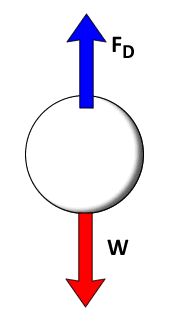
Problem Statement:
A golf ball is dropped from the observation deck of the Empire State Building at a height of H = 320 m above the ground. How long will it take the ball to reach the ground? Assume the golf ball weighs 0.44 N and has a diameter of D = 4.29 cm and a drag coefficient of about 0.25. You may also use the fact that air has a density of 1.20 kg/m3 at sea level.
Solution:
When the ball is dropped, it will start to accelerate under the force of gravity. As it accelerates, the drag resisting the motion of the ball will increase. Eventually the drag on the ball will equal the weight of the ball and it will stop accelerating (the net force on the ball will be zero).

At this point the ball has reached its "terminal velocity," VT. If we ignore the acceleration period (assuming it is short), then the time to reach the ground can be computed as

To find VT, we use the fact that W = FD. Inserting the equation for FD we get

In this case the area A is the cross-sectional area, A = πD2/4 = 1.45 × 10-3 m2. Then,

[Recall that 1 N = 1 kg·m/s2.] Finally, the time for the ball to reach the ground is

